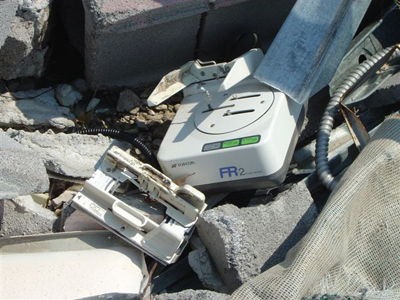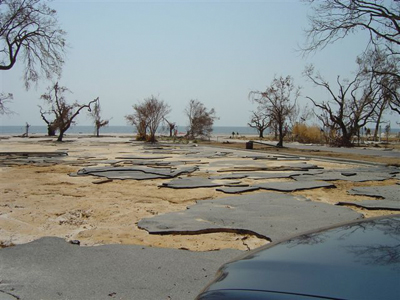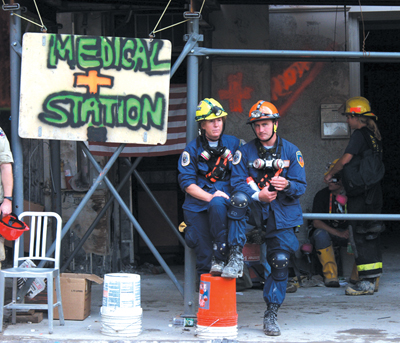Do you remember playing hide-and-seek as a child? Ready or not, here I come, youd say.
This same principle applies to disaster planning. However, the stakes are bigger, a lot more devastating and can surface unexpectedly.
This has become especially clear following the events of 9/11 and Hurricanes Katrina and Rita, not to mention tornadoes, floods, fires, mudslides, earthquakes attack almost everything except pestilence.
Even the best-laid plans may not totally protect you, but thorough disaster planning can go a very long way toward mitigating your damages and hastening your recovery. As business owners and health-care practitioners, we have an obligation to plan and prepare for disaster to protect our employees, our patients, our records and ourselves.
 |
|
Equipment from an O.D.s office in Pass Christian, Miss., is found among debris following Hurricane Katrina. When planning for possible disasters, evaluate your insurance needs. For example, you may need to consider purchasing hurricane coverage. |
1. Back Up Computer Records
Maintain on- and off-site backup of your computer records should a power or hard-drive failure occur or should you need to access them off-site. Make backing up a habit that you document regularly.
When backing up information, be sure to:
Record all lab account numbers, addresses, phone numbers and computer login information.
Document all equipment (leased or owned), along with serial numbers and leasing company information when appropriate. Include the date of acquisition and initial cost of the equipment. Photodocumentation should accompany this list.
Keep a master list of all user names/passwords for any computer accounts.
2. Mind Your Business
Steps to protect your practice during a disaster include the following:
Photodocument your entire office and contents as completely as possible for insurance and replacement purposes. A digital camera may work best, as you can download the photos to your home and office computers. Strongly consider storing this information with an out-of-area family member as well, in the event of a widespread area catastrophe.
Copy or record all legal and business documents. These include any partnership agreements, bank information, office leases, building ownership information if you own the premises and employee documentation.
Also, copy and record insurance policy information, including agent, policy number and telephone contact. All insurance information should be itemized: office, health, employee, professional liability, premises, etc. You need a master list not just for reimbursement purposes but for documentation and record-keeping to run the office either at the same or different location.
Plan for continuity. Dont forget about emergency payroll, expedited financial decision-making and accounting systems to track and document costs following a disaster.
Secure all filing cabinets, equipment, drawers and computers to avoid breakage, destruction or projectile injuries. Consider elevating equipment off the ground to avoid electrical hazards in the event of flooding.
Check on possible dangerous natural hazards. Is your office located in a flood plain, along an earthquake fault, etc.? Consider reinforcing your building or taking pre-disaster safety precautions, such as reinforcing or attaching your equipment and other large objects, cabinets, etc. to prevent falling and damage.
 |
|
This is what remained of the parking lot at the same optometrists office in Pass Christian, Miss. |
Make certain you have a plan in place to secure the office and all records. This includes closing the office, boarding it up, backing up records or keeping backup copies in another location and locking up all records to prevent vandalism.
Post your whereabouts. Place a large conspicuous notice on the office indicating where you can be reached in the event your office is closed or inaccessible to patients or delivery personnel.
3. Plan Your Exit
Develop and post an emergency exit strategy from the office. All exits must be clearly labeled, along with fire extinguishers, etc. First-aid kits (and manuals) should be easily accessible, along with flashlights or emergency lighting, rope, etc.
Elevators may not be safe during an emergency. So, if your office is more than one story high, consider having a rope ladder, or evaluate alternate means of escape. Also, check all fire doors for accessibility; they should be unlocked and unblocked. All employees should know how to turn off the water, gas and electricity if necessary.
Know where the closest emergency shelters are. These may include airports, hospitals and military bases. Maintain a master list of all area hospital emergency rooms and urgent-care clinics, with directions and phone numbers.
Conduct annual emergency evacuation and safety drills. Have staff members sign off on their understanding and completion of the drill as part of their employee record.
If appropriate, be certain you have a shelter area in the event of a tornado or severe wind. Dont forget the need to seal the room in the event of a chemical or air contamination emergency. Inspect and re-evaluate your building air to minimize microscopic particles that would be spread during earthquakes, biological or chemical airborne threats, fire, etc.). Look at your heating, ventilation and air-conditioning system, and check for gaps under doors.
Dont forget to maintain (and rotate) emergency water and food supplies. These include small amounts of nonperishable food. Also consider having a whistle, dust mask, pliers or a wrench, a hatchet or axe, blankets and rain gear. Finally, consider buying an emergency generator for the office.
4. Protect Your Employees
It will take twice as long as you think to get your office back to full speed, but supporting your employees health after a disaster can help hasten this process. Make certain you discuss your emergency plans in advance of any disaster so that everyone is prepared and knows what to do.
Also, make sure employees have discussed how to contact family members and where to meet them in the event of an emergency. This is particularly critical if the employee has children or grandchildren in local schools, is a caregiver, or if family members commute from great distances. Everyone should have a primary meeting place, a back-up location, and an out-of-area contact number of a friend or family member in the event of a massive disaster or inability to reach anyone locally.
 |
|
Medical rescue workers await casualties following the September 11, 2001, attack on the World Trade Center. Develop and post an emergency exit strategy for the office and know where the closest emergency shelters, including urgent care clinics, are located. |
If you have any animals on your office property, dont forget to plan for their care as well. Pets should be microchipped and licensed. Food and water should be available along with appropriate carriers and/or leashes.
5. Plan for the Big Picture
A final contingency plan should be part of your overall picture. This plan should include whom to contact in the event of a major disaster, where practice records may be accessed, possible locations for patient care, and a list of all staff and doctor phone numbers and emergency contacts.
Your crisis communication plan should detail how to contact each other. All office personnel should have a means of contacting you and each other (cell phone and e-mail) to facilitate a rapid return to work and patient care.
If you have warning of an impending disaster, everyone should know what documents, equipment, etc. should be saved and in what order of importance. Maintain this list in a clearly visible location in the office. Items to include: accounts receivable, monthly day sheets, employee records, artwork (i.e., paintings), equipment, etc. It is critical that everyone know what is important and what is replaceable or of low importance.
Another suggestion: Have the numbers or Web sites of emergency assistance sources, including the Federal Emergency Management Agency (FEMA) as well as state and local numbers. (See Emergency Resources, below.) Contact your city and county governments for information on emergency, disaster and evacuation plans, or check with your state office of emergency services. Your national and state optometric associations may be of assistance as well.
|
Emergency Resources Insurance Information Institute. You can find information about taking a home inventory and download software to help you by logging on to www.iii.org. The Department of Homeland Security National Cyber Alert System. You can subscribe by logging on to www.us-cert.gov. US-CERT, which stands for United States Computer Emergency Readiness Team, offers alerts of cyber security threats and advice on protecting your computers. Ready AmericaU.S. Department of Homeland Security. You can log on to www.ready.gov, and use the seven-page Sample Business Continuity and Disaster Preparedness Emergency Plan developed by the U.S. Department of Homeland Security to get you started in preparing a disaster plan. |
After an emergency, you will be swamped with just trying to keep your practice afloat. Although we all hope that we never have to face a catastrophic event, we simply cannot rule it out. The fact is that preparing now just makes good business sense.
If you never have an emergency or suffer a disaster, that is terrific. If, on the other hand, you have planned for chaos, you will be way ahead of the game.
Dr. Miller is in private practice in Highland, Calif., and works as a practice-management consultant and expert witness. She lectures and publishes extensively and has written seven books.

